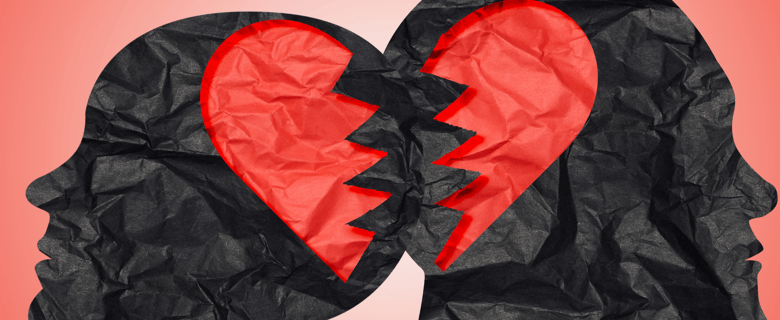"What we call love is often a reflection of our desires, fears, and the pull of chemistry; real love exists only when illusions fade."
The Science and Psychology of Heartbreak: Why It Hurts and How to Heal (a Three-part Series)
Explore the neuroscience behind heartbreak, from dopamine withdrawal to attachment theory. Learn why modern breakups hurt differently and discover evidence-based healing strategies.
MENWOMEN
Ellen Mouton
2/22/20255 min read



Why Heartbreak Hurts and How to Heal
(a Three-part Series)
Hey friends,
Welcome to the first edition of our three-part series on understanding and healing from heartbreak. Over the next few weeks, we’ll explore heartbreak’s emotional, psychological, and physiological impact, providing insights to help you heal.
Understanding Heartbreak Beyond the Surface
Heartbreak is an intense experience that many of us encounter throughout life. It can feel overwhelming, isolating, and profoundly painful. While we can all relate to the emotional impact, our coping mechanisms have evolved significantly over the years.
In the past, breakups often allowed for emotional separation. We didn’t have constant reminders of our exes through social media, text messages, or apps. This provided space for reflection and healing at our own pace. Healing occurred with the support of our communities—friends and family were easily accessible to offer comfort, advice, or simply companionship.
Today, we face new challenges. With the relentless buzz of social media notifications, escaping reminders of the past becomes impossible. As we scroll through our phones, we often find ourselves feeling alone, which hinders our ability to truly heal. Even when we are with others, we may feel disconnected, which can lead to emotional isolation.
Why Heartbreak Feels Different Today
Heartbreak feels different today because the environment has changed dramatically. We inhabit a world designed for instant gratification—everything, from social media to texting, triggers dopamine, the brain’s reward chemical. This constant reward makes emotional detachment from a breakup much more challenging. Your brain becomes addicted to the emotional highs you experienced in the relationship. When those highs vanish, you experience withdrawal, much like someone battling addiction. This makes the healing process incredibly difficult—it’s not simply emotional pain; it’s biological. Your brain is adapting to the loss, and this physical pain can feel just as genuine as the emotional one.
The Biology of Heartbreak: Why It Hurts So Much
Heartbreak isn’t merely a psychological experience—it’s physical as well. Research by Eisenberger et al. (2003) found that emotional pain from a breakup activates the same areas of your brain as physical pain. This connection explains why you experience physical discomfort, such as tightness in your chest, difficulty breathing, or weakness. It’s genuinely painful.
When a relationship ends, your brain undergoes significant stress as it loses the emotional comfort and dopamine release that came with the partnership. This sudden loss can trigger reactions similar to withdrawal from an addiction. As a result, you might experience anxiety, insomnia, and mood swings, along with other physical symptoms such as fatigue and changes in appetite. These responses reflect your brain's struggle to cope with the emotional turmoil resulting from the breakup.
Helen Fisher’s Research on Heartbreak
Helen Fisher, a biological anthropologist and leading expert on the neuroscience of love, has studied the brain’s response to love and heartbreak. She explains that heartbreak can be as traumatic as physical injury, noting:
“We can live for love, kill for love, and die for love.”
Fisher identifies three main love systems that evolved over time to help us connect with others:
Lust: The biological drive for attraction triggered by testosterone and estrogen.
Romantic Love: Addictive love driven by dopamine, leading to intense passion and desire.
Attachment: A deep bond that forms when we decide to build a future together, providing stability and commitment.
Heartbreak occurs when the romantic love system fades, but the attachment system stays active, making it incredibly difficult to move on.


Why Attachment Makes Heartbreak So Hard
We’re hardwired for attachment. From a young age, we seek emotional connections that make us feel secure. In romantic relationships, these bonds provide emotional fulfilment. When a relationship ends, we’re not just losing the person—we’re losing that emotional support system we built.
This isn’t just emotional pain; it’s biological. The sudden drop in oxytocin (the “bonding hormone”) and dopamine sends your body into fight-or-flight mode, leading to anxiety, depression, and distress. These physical symptoms intensify the heartbreak experience.
This is why those with anxious attachment styles often experience breakups more intensely. Their brains are wired to constantly seek reassurance and emotional closeness, making the loss feel even more significant.
Grief and Heartbreak: The Stages and Their Impact
Grief is the emotional response to loss, and heartbreak often mirrors the stages of grief identified by Elisabeth Kübler-Ross. The five stages—denial, anger, bargaining, depression, and acceptance—are typically experienced, but they don’t always follow a linear pattern.
Denial: The hope that the breakup is temporary, causing emotional conflict.
Anger: As reality sets in, resentment toward the other person or the situation arises.
Bargaining: Trying to determine what could’ve been done differently to save the relationship.
Depression: The overwhelming sense of loss feels like an emotional void.
Acceptance: Eventually, with a lot of self-compassion, you accept reality and begin to heal.
Why Heartbreak Feels More Complex Today
In today’s world, breakups involve far more than ending a relationship. Social media, dating apps, and a culture of instant gratification influence how we heal. Even after a breakup, we often see our ex’s life moving forward, which makes us feel stuck.
Dating apps have made it feel like love is disposable. In a world where we’re always connected, it’s easy to rush into rebound relationships, trying to fill the void left by a former partner. But doing so only delays the healing you genuinely need.
Conclusion: Understanding the Depth of Heartbreak
Heartbreak is a complex process—it affects you emotionally, psychologically, and biologically. The pain you feel is valid; your brain and body respond to the loss of attachment.
Healing takes time, but understanding the science behind heartbreak makes it easier to process the pain without feeling broken. Acknowledge your emotional pain and give yourself the time to heal without rushing the process
Reflection Questions for You:
How has your understanding of heartbreak changed after reading this?
What physical symptoms have you experienced during heartbreak?
How can you begin to acknowledge your emotional pain without rushing the healing process?
Next week, we’ll explore Part 2 of this series, where we’ll look at the biggest mistakes people make when trying to move on and how to avoid them. Stay tuned for more insights on healing and breaking free from old patterns.
For the full deep dive into chemistry love and compatibility, including expert insights and strategies and free tools to break free from toxic cycles, subscribe to my full-length unfiltered newsletter. Get it here
Recommended Reading
“The Female Brain” by Louann Brizendine (Buy on Amazon)
“Why Men Love Sex, and Women Love Love” by Allan and Barbara Pease (Buy on Amazon)
“The Chemistry Between Us” by Larry Young and Brian Alexander (Buy on Amazon)
Further Exploration
Videos:
Oxytocin, Vasopressin, and Dopamine’s Role in Bonding: A video that delves into the roles of these hormones in romantic relationships and bonding.
youtube.comDr. Tara Swart — What Science Says About Non-Monogamy: In this discussion, Dr. Tara Swart explores the neuroscience behind monogamous and non-monogamy relationships, shedding light on evolutionary mating strategies.
youtube.com
Articles:
Oxytocin, Dopamine, and Opioid Interactions Underlying Pair Bonding
Behavioural and cardiovascular consequences of disrupted oxytocin communication in cohabitating pairs of male and female prairie voles . Soc Neurosci. 2019. Read here.
Oxytocin Modulates Social Distance between Males and Females
November 14, 2012 — Research on monogamous mammals, particularly prairie voles, has shown that the neuropeptide oxytocin (OXT) promotes the formation of pair-bonds . Read here.
Love and the Brain | Harvard Medical School
Released during sex and heightened by skin-to-skin contact, oxytocin deepens feelings of attachment and makes couples feel closer to one another after having. Read here.
Ellen Mouton
